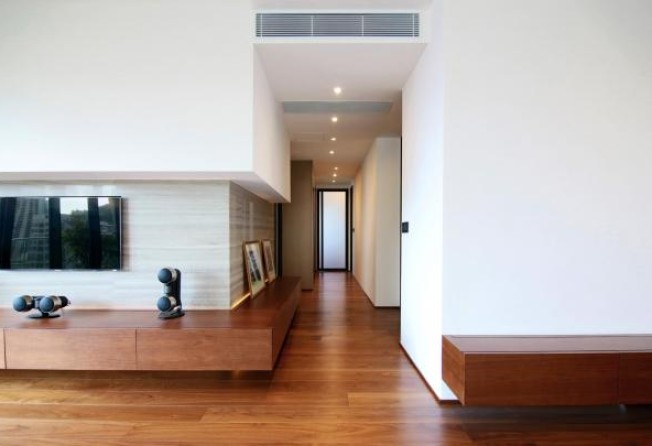Clever design strategies to cover up unsightly items
Unsightly but necessary items such as air conditioners can be a visual nightmare, but clever design strategies make such problems disappear

There's always one area of the home that looks a bit unsightly. Kitchen bins, for instance, will never be something you show off. Neither will a water heater. And while such things can often be tucked away in a cupboard, there are other essentials that seem almost impossible to hide.
"Air conditioning units are a constant source of difficulty in Hong Kong," says Bun Ho, design director of local interiors firm Su:b Design. "People want to hide them, but they have to have a physical presence in the room or else they're completely redundant. We frequently deal with split air conditioning systems and they are particularly troublesome. Not only do you have the main unit but you also have the piping that leads outside."
Ho says the only real way to deal with an unsightly air conditioner is to create a suitable cover that makes it blend with its surroundings. Although covering a split air conditioner may impede performance, if you can't install a more complex system, it's an unfortunate trade off if you're determined to disguise it.
The philosophy is sound and, if Su:b Design's recent project in Tin Hau is anything to go by, clearly effective. Ho says: "This particular apartment was around 1,100 sq ft. We approached the project with the concept of reducing the number of visible elements in the space. From obvious unsightly features like the air conditioning units to things that would normally be left exposed, such as shelving, our aim was to conceal as much as we could. What was left, then, was a modern looking, functional space."
To fully realise this minimalist look, Ho's team carefully planned the interior layout. Once storage, shelving and air conditioners were in place, they used a uniform pattern of white panelling on the interior walls.
Because every panel looked the same, this let them disguise what was a solid wall and what was hiding something. This was particularly effective on the air conditioners. Here, a single panel covers the main body of the unit but the air flows through a hole cut in the same style as the regimented divisions between each panel.
Ho's team also hid a bed. When not in use, it folds up into a wall. In fact, the only break from the white panelling is a wall that appears to be a feature mirror. It's actually a sliding panel with shelving hidden behind.
Liquid, a local full service interior design consultancy, places a great deal of importance on the things you don't see rather than those you do. Rowena Gonzales, the firm's creative director, says: "Before you even start, it's very important to consider how you are going to conceal those items you don't want out in the open."
Liquid's elegant redesign of a luxury apartment on MacDonnell Road demonstrates the extent to which the firm goes to hide unsightly but essential components. For example, they laid a new floor in the apartment just to provide hidden conduits for the client's speaker cables.
"A design like that can be pretty unforgiving," Gonzales says. "The client has to know exactly what they want, because once a stereo or TV is in place, that's where it stays. Hiding unfortunate looking features is much easier if you're refurbishing an entire apartment, although a proper interior designer can always apply a combined ceiling plan to create a false ceiling in order to hide things like air-conditioning units. In Hong Kong that's not always practical because ceilings are often too low to begin with and people don't want to sacrifice the height."
In these cases, Gonzales recommends making a feature cover. The firm recently used an elegant antique style Chinese wooden screen to turn an ugly air conditioner into a beautiful feature. Gonzales says another common nasty is the mini-extractor fan frequently built into kitchen windows. Nicknamed "pignose" fans, they are often concealed under custom-made covers.
Thankfully, there are some clever products that will disguise this necessary evil. Among them is the pendant extractor from Italian kitchen specialists Gruppo Del Tongo. Available from Hong Kong's Kitchens + Interiors on Duddell Street in Central, this clever design, which costs HK$30,000, sees a large circular extractor fan hidden inside a hanging light pendant when not in use. When cooking, it can be pulled down to filter the air directly over the stove top.
If that's not enough, Gruppo Del Tongo's Monos range of kitchens all have elements that have been designed to be hidden. Perhaps the most dramatic, and not just in price (HK$318,000), has a full-sized sink and a four-burner stove top slide beneath a solid counter. It is a surprising, yet simple, design.
Just as Del Tongo's slide-away kitchen lets you disguise what a space is really used for, similar tricks can be a clever way to increase the flexibility of any space. Hong Kong interiors firm Jason Caroline Design recently hid an entire entertainment centre behind a living-room mirror in a 1,500 sq ft Central apartment.
Jason Yung, the firm's director, says: "Our client wanted a clean, simple space that they could hold meetings in. Finding a way to hide the TV was essential because it was the feature that changed the whole atmosphere of the room. The challenge, then, was to make sure that when you need it, the TV was there but when you didn't, it vanished."
Yung's design saw the firm mount a custom-sized television behind a special mirror. In what seems like the stuff of science fiction, when the television is on, the mirror becomes transparent but when not in use it's invisible.
"Good design should be clean looking with as many of its elements hidden as possible," says Yung. "From simple cables and air conditioners to speakers and fridges, if you think about it, you can hide almost anything."